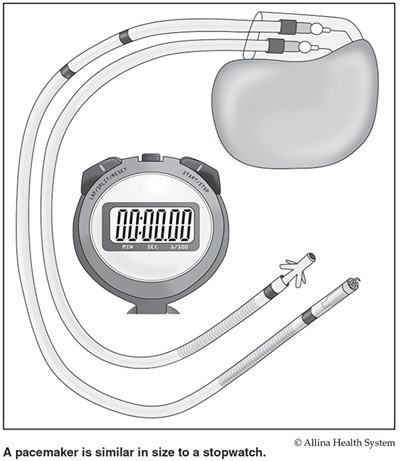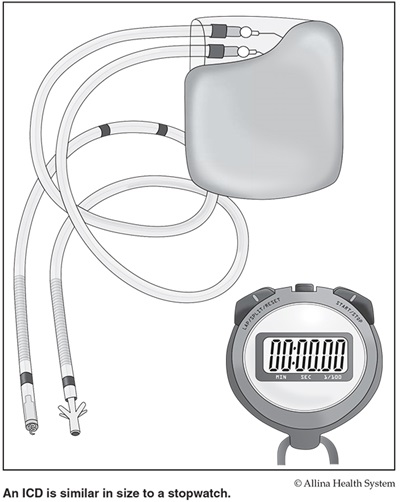
Pacemakers and implantable cardioverter defibrillator (ICD)
 Pacemakers
Pacemakers
A pacemaker is a device that may be recommended if your heart beats too slowly or skips or misses beats from time to time.
Parts of a pacemaker
A pacemaker has two parts:
- a pulse generator: this holds the battery and a computer that can sense when changes in your heart rate and rhythm happen
- lead wires (one to three): these monitor the electrical impulses generated by your heart and send information back to the pacemaker
The pacemaker will help your heart beat at a desired rate on a regular basis. It can be programmed to react to activity levels based on your needs.
How a pacemaker is implanted
You do not need to have open heart surgery to get a pacemaker. Placing a pacemaker is a procedure done in a special procedure room in the cardiac lab. It can be placed on either the left or right side of the chest, but is most often placed on the left, just below the collarbone.
Talk with your doctor if you have special reasons to have the device placed on one side or the other, such as being left handed, or if you hunt using a rifle.
The procedure usually takes up to 2 hours. You may spend one night in the hospital before you return home.
The pacemaker will help your heart beat at a desired rate on a regular basis. It can be programmed to react to activity levels based on your needs.
Activity and exercise
Having a pacemaker doesn’t mean you can’t live an active lifestyle. Many people find that their ability to tolerate physical activity and exercise improves once they have a pacemaker in place.
Talk with your doctor if you play contact sports.
Living with a pacemaker
- Please keep all follow-up appointments with the pacemaker clinic. A staff member will tell you when and how to schedule your follow-up visits.
- Your pacemaker will need to be checked on a regular basis to make sure that everything is working well.
- Over time, your pacemaker’s settings may need to be adjusted. This can be done using a pacemaker programmer. This does not involve any type of procedure or surgery.
- Most machines and devices will not interfere with the way your pacemaker works.
- You may use a cell phone. Hold it to your ear on the opposite side of your pacemaker. Do not carry a cell phone in a shirt pocket right over your pacemaker.
- If your line of work involves welding, electricity or large engines, you will receive specific directions about restrictions.
- Unless your pacemaker generator and wires are “MRI-compatible,” you should not have an MRI scan.
- If you will be having other surgery or procedures, make sure those health care providers know you have a pacemaker.
- You will receive directions about travel and which security devices are safe for your pacemaker.
- During your routine pacemaker checks (interrogations), you will receive information about the pacemaker’s battery life and overall function.
 Implantable Cardioverter Defibrillator
Implantable Cardioverter Defibrillator
An implantable cardioverter defibrillator (ICD) is a device that may help correct fast heartbeats coming from the lower chambers of the heart. These rapid rhythms can be life-threatening. An ICD monitors the heart and delivers a shock or special pacing therapy to restore the heart to a normal rhythm.
Parts of an ICD
An ICD has two parts:
- a pulse generator: this holds the battery and contains a computer that can sense when changes in your heart rate or rhythm are potentially dangerous.
- lead wires (one to three): these monitor the electrical impulses produced by your heart and send information back to the generator.
If your heart rate is too fast, or if the leads detect a life-threatening arrhythmia, a shock can be sent through the wire in the lower right chamber of your heart to attempt to reset the rhythm, slow the heart rate, or both.
Some ICDs also may treat fast rhythms with a special type of pacing therapy. Rapid pacemaker impulses may be sent to the lower chamber to “catch up” with, and then slow down the fast beating.
ICDs also act like pacemakers. Sometimes, the pacemaker is programmed to work in the event of a slow heartbeat that happens following a shock. Sometimes, the pacemaker is programmed to work all the time to correct slow heartbeats or to coordinate the contraction of the lower chambers.
How an ICD is implanted
Placing an ICD does not require open heart surgery. It is a procedure done in a special procedure or operating room in the cardiac lab. It can be placed on either the left or right side of the chest, but is most often placed on the left, just below the collarbone.
Talk with your doctor if you have special reasons to have the ICD placed on one side or the other, such as being left handed, or if you hunt using a rifle.
The procedure usually takes up to 2 hours. You may spend one night in the hospital before you return home.
Living with an ICD
- Please keep all follow-up appointments with the ICD clinic. A staff member will tell you when and how to schedule your follow-up visits.
- Your ICD will need to be checked on a regular basis to make sure that everything is working well.
- Over time, your ICD’s settings may need to be adjusted. This can be done using a ICD programmer. This does not involve any type of procedure or surgery.
- Most machines and devices will not interfere with the way your ICD works.
- You may use a cell phone, but hold it to the ear on the opposite side of your device. Do not carry a cell phone in a shirt pocket directly over your ICD.
- If your line of work involves welding, electricity or large engines, you will receive specific directions about restrictions.
- You should not have an MRI scan.
- You will receive directions about travel and which security devices are safe for your ICD.
- If you will be having other surgery or procedures, make sure those health care providers know you have an ICD.
- During your routine ICD checks (interrogations), you will receive information about the ICD’s battery life and overall function.
- Having an ICD doesn’t mean you can’t live an active lifestyle. Talk with your doctor if you play contact sports.